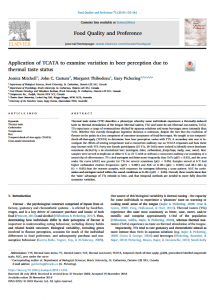Application of TCATA to examine variation in beer perception due to thermal taste status
 Thermal taste status (TTS) describes a phenotype whereby some individuals experience a thermally-induced taste on thermal stimulation of the tongue (thermal tasters; TTs) and some do not (thermal non-tasters; TnTs). TTs experience a range of orosensations elicited by aqueous solutions and some beverages more intensely than TnTs. Whether this extends throughout ingestion duration is unknown, despite the fact that the evolution of flavour on the palate is a key component of consumer acceptance of food/beverages.
Thermal taste status (TTS) describes a phenotype whereby some individuals experience a thermally-induced taste on thermal stimulation of the tongue (thermal tasters; TTs) and some do not (thermal non-tasters; TnTs). TTs experience a range of orosensations elicited by aqueous solutions and some beverages more intensely than TnTs. Whether this extends throughout ingestion duration is unknown, despite the fact that the evolution of flavour on the palate is a key component of consumer acceptance of food/beverages.
We sought to use temporal-check-all-that-apply (TCATA) to determine how beer perception varies with TTS. A secondary aim was to investigate the effects of serving temperature and a concurrent auditory cue on TCATA responses and how these may interact with TTS. Forty-one female participants (21 TTs, 20 TnTs) were trained to identify seven dominant sensations elicited by a de-alcoholized beer (astringent, bitter, carbonation, fruity/hops, malty, sour, sweet). Beer samples were served in duplicate at either 6 °C or 21 °C with or without a concurrent auditory cue consisting of a sound clip of effervescence. TTs cited astringent and bitter more frequently than TnTs (p(F)≤0.01), and the area under the curve (AUC) was greater for TTs for several sensations (p(t)<0.05). Samples served at 6 °C had higher carbonation citation frequencies (p(F)<0.001) and AUC at 0-30s (p(t)<0.001) and 30.1-60s (p(t)<0.05) than the warmer samples, with responses for astringent following a same pattern. AUC for carbonation and astringent varied within the sound conditions at 0-30s (p(t)<0.05). Overall, these results show that the ‘taste’ advantage of TTs extends to beer, and that temporal methods are needed to more fully describe consumer variation.
![]()
Mitchell, J., Castura, J.C., Thibodeau, M., & Pickering, G. (2019). Application of TCATA to examine variation in beer perception due to thermal taste status. Food Quality and Preference, 73, 135-142. https://doi.org/10.1016/j.foodqual.2018.11.016.